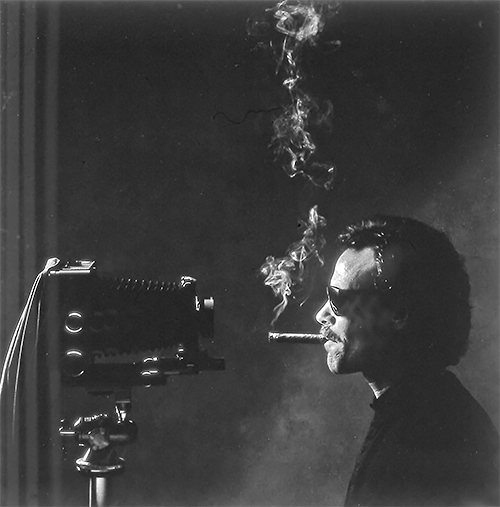Not as many photographers
load cameras anymore, but we all still
aim them and
shoot pictures. You might say, I get a bang out of describing my own photographic pursuit as hunting for big
game, portraits in particular. I bag my quarry with a four-by-five instead of a thirty-aught-six.
But I still hang their heads on a wall to admire like trophies
The memorialization of a deliberate encounter with a human being — in one shot, so to
speak — epitomizes the hunt. When it goes well, it’s because the subject has allowed me to
reveal something personal within a two-dimensional frame, a graphically compelling
composition embellished with shadow and light — sometimes color, too. The late, great Arnold
Newman summed up all the hard work with his quip: “Photography is ten percent inspiration and
ninety percent moving furniture.” It’s now an insiders’ cliché, but I remember laughing out loud
when he said it to me personally, decades ago. It still brings on a smile after every exhausting
shoot. I’ll add that, despite one’s best attempts to prepare in advance, any photoshoot can go
sideways and, like a MacGyver episode, it becomes necessary to solve a cascade of unexpected
trials involving lenses, lights, cameras, props, wardrobe, location, deadlines, weather,
temperament . . .
furniture. Sometimes the big one gets away.
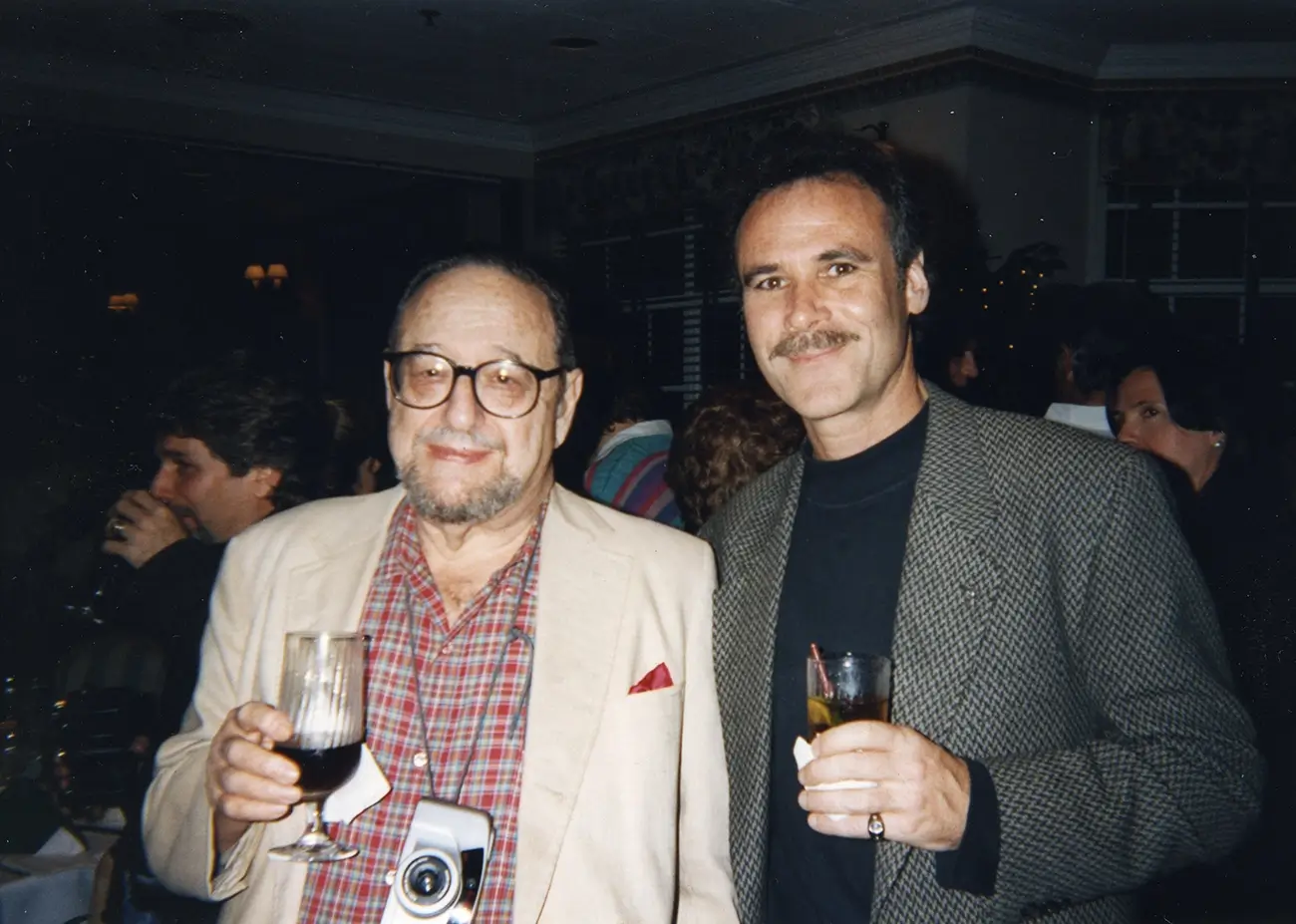
Arnold Newman and Tom Zimberoff
More than illustrations of interesting people or handsome faces, portraiture is about making
visual allusions to character with artistic integrity. An adept portrait photographer tries to show
as much about what someone does, often vocationally, as much as who they are personally. To a
lesser extent, a portrait may say something about the photographer’s relationship with the
subject. Ultimately, however, that relationship is the photograph. Nothing more. Nothing less.
Only rarely does a lasting personal relationship ensue. But always, a record remains of what they
saw, looking at each other, or at what it was agreed should hold the subject’s gaze. It is that
moment, frozen in time, when the camera becomes a surrogate for either one viewer or a large
audience.
Looking at a photographic portrait is a kind of hack of human psychology because you
can stare right into someone’s eyes with no compulsion to flinch and look away. It is also crucial
to recognize how inescapable it is to form an idea about what the subject of a portrait is thinking
or feeling, even though that person (or persons) is observed neither in real-time nor moving
about in the real world. And don’t miss the irony of losing your sense of self in this condition,
looking closely and intimately at someone else. It is an experience of becoming self-effaced
while looking at someone else’s face. Portraits help us understand that people are always looking
at us and that we are all subject to someone else’s perception.
Today, everyone has a camera. We all take pictures. We’ve all had our picture taken, often
with family and friends. We’ve all got our selfie faces now, too. But the experience of being
portrayed can hardly be taken for granted. It is an act of total engagement, usually with a
stranger. The photographer is the stranger.
Not as many people as you might think have been invited to experience a photographer’s
punctilious attention. But we all know how uncomfortable it is to take direction, to be manipulated
into a pose. It is even more unnerving to be stared at through a lens. You are precisely the subject of
attention, sometimes in an alien environment: a forest of light stands, cables, umbrellas, gobos,
cucolorises, snoots, booms, and barndoors . . . flinching at the loud pop and bright flash of strobes.
It’s possible to encounter production stylists, photo assistants, and art directors hovering about, too.
(You may be the subject but you’re treated like an object.) Nonetheless, even with no more than a
camera on a tripod, whether shooting outdoors with only sunlight and shade or indoors with light
coming through a window, every successful portrait is contrived — in the best sense of the word.
Portraiture is a collaborative effort executed with deliberation and care. It takes time You
can’t
take a portrait: a portrait is
made. Otherwise, it’s merely a snapshot.
Because
snapshot can sound dismissive, I'll use
candid. Too often, I’ve seen how
candidly-captured photographs — irrespective of artistic merit but just because people are
included in the composition — have been carelessly categorized as portraits by influential people.
If such a photograph is, for example, excerpted from a documentary project that features people
occasionally glancing at the camera or making deliberate eye contact with the photographer’s
lens, the distinction between documentary photography and portraiture is muddled to the
detriment of both genres. My point is, the notion of a spontaneous, unplanned, or unstructured
portrait — a “candid portrait” — is an oxymoron. Portraiture is a very specific discipline. It is an
art form, not a format.
Portraits include candid likenesses, of course, but in the context of
candid
meaning honest and sincere, which includes unexpected mannerisms and expressions. We take advantage
of spontaneity but we do not capture anyone’s likeness surreptitiously; our subjects participate
knowingly. And there’s planning, a prerequisite for any photograph worthy of being called a
portrait. While serendipity adds magic, it is incidental to the conceptual rigor that goes into a
telling portrait, the ideas thought out long before a camera is brought to a photographer’s eye.
This is not semantic nitpicking. Conflating candid photos with portraits diminishes the
legacies of
August Sander, Arnold Newman,
Richard Avedon, Irving Penn,
Yousuf Karsh,
Philippe Halsman, et al. . . . plus many more contemporary portrait artists. Though we welcome
evolving photographic styles, there is a difference between style and substance. I’m not the portrait police, but misclassifying the essential properties of portraiture confuses its conceptual
integrity vis-à-vis other photographic genres. It causes confusion. For instance, conflating
documentary projects (pursuing an agenda) and also photojournalistic reportage (bearing witness
to events) with portraiture allows the advocacy of political or societal issues to creep insidiously
closer to taking precedence over the quality of photographic execution and its expression as
portraiture. If the content depicted in any given photograph takes precedence over the intrinsic
quality of the photograph itself, is that art?
Lately, I’ve witnessed an increase of inaccurate information that has spread like a game
of telephone from one academic institution to another, or from one curator to another, until what
was once “this” has becomes “that” within their insular world. Thus calcified into flawed
doctrine, this misinformation perpetuates institutional biases and leads to a homogenization of
artistic standards and institutional memory loss — call it photographic memory loss if you will.
I recently attended a photo symposium populated with several dozens of gallerists,
curators, and photographers, many of them anointed with MFA degrees from Ivy League
colleges, who couldn’t recognize the names of at least a dozen influential photographers included
in the fine-art photography canon. These MFA photographers were at a loss to either recognize or
describe photographic techniques that have been commonplace for decades. I think the internet is
largely to blame, as it is too often relied on as the ultimate authority for professional inquiries,
even by some academics who have apparently been unwilling to perform their own due diligence
about the sources of the websites they’ve queried, having yet to learn that the presence of a
website should not be mistaken for its plausibility.
Despite being sharply focused, well-exposed, and adequately composed, many pictures of people
are souvenirs made on the fly by camera enthusiasts and tourists. Did the photographer really
take the picture, an act of theft? Or did the subject acknowledge the taking (away) of it?
Awareness notwithstanding, was there consent? Photojournalists, I concede, will and must
include stereotypical depictions in their reportage, but these will only be grace notes to
complement a larger set of pictures that, when well-edited, tell a broader story. When seen on
their own, however, do such photographs truly exhibit the hallmarks of a portrait? Personally, I
don’t think so.
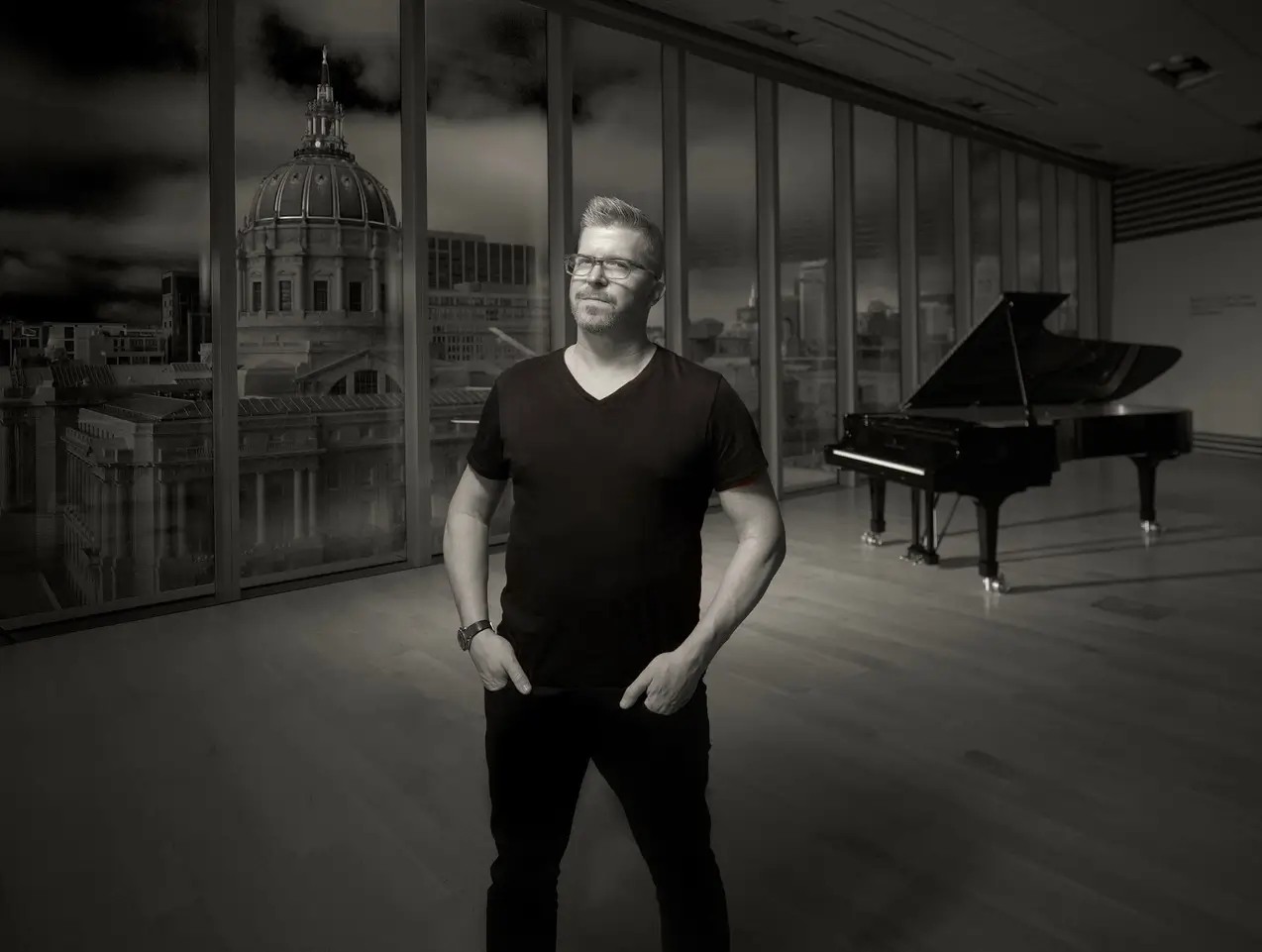
Edwin Outwater © Tom Zimberoff
To be considered a portrait, a photograph should be more than an agreeable or photogenic likeness of someone. That means a depiction should be more than superficial; it should dramatize one aspect or another of its subject’s persona by telling a story, and the story must be told with concision; and not about something that just happened to that person — because that’s reportage — but about who that person really is. Empathy, too, plays a part. But the concept of a portrait does not include the proselytization of a moralistic message. If an individual photograph is removed from a project to be displayed on its own, irrespective of whether the theme of that series is celebratory or poignant — or moralistic, that example must be able to fly on its own aesthetics. However, with exceptions, any number of ostensible portraits expected to go solo quickly crash land, victims of their own inconsequence when seen out of context.
Whether shot with an iPhone, a $20,000 digital Hasselblad, or an oatmeal box with a
pinhole, a portrait is the result of a photographer’s interaction with a sitter. It is rarely a
photographer’s one-sided depiction because, to one degree or another, it reflects the sitter’s
intellectual participation. It should also be self-evident why it was made, certainly not to recreate
a cliché. In the hands of an artist, even an iPhone or an oatmeal box is a fine tool for creating
portraits — even a self-portrait. Only the result counts, not the kind of camera. The camera is
merely a tool.
The reductive drama conveyed by black-and-white works for many photographers when
character is the essential theme of a portrait, particularly when focused tight on someone’s face.
Color, particularly because it may be complementary if not integral to a composition is not to be
disdained. Besides, it’s usually obvious when something doesn’t look right without color or
looks appreciably better because of it. It is also obvious at the outset, to a practiced pro, which
medium to choose (unless a client makes that decision), although both a color and a black-and-
white version can sometimes be equally compelling.
Sometimes one popular example is consecrated as
the
definitive portrayal of someone or another, as if the photographer knew how to distill and bottle some mythical essence of character. I
don’t buy it. That notion only applies to pictures that agree with what we think we already know
about someone; celebrities, for example. It’s not possible to reveal all of a subject’s life story in one
shot, just one aspect of character in that particular instant. Character is too complex, hardly one-
dimensional or immutable. And no photographer has the preternatural power to evince an entire
range of personality in the wink of a lens. A portrait can, however, achieve iconic status as a “best
portrayal,” powerful enough in its expression of identity to stick and be forever associated with
someone. Yet it illustrates only one aspect of a person’s character at one moment in a lifetime.
Yousuf Karsh’s powerful portrait of a glaring Winston Churchill (because Karsh swiped the cigar
out of his hand) comes to mind. And though one portrait can jumpstart a photographer’s career, I
can’t think of one portrait that has defined a photographer’s career. It takes a lifelong body of work
to do that. The Churchill portrait jumpstarted Karsh’s career, and his subsequent work influenced a
generation of portraitists.
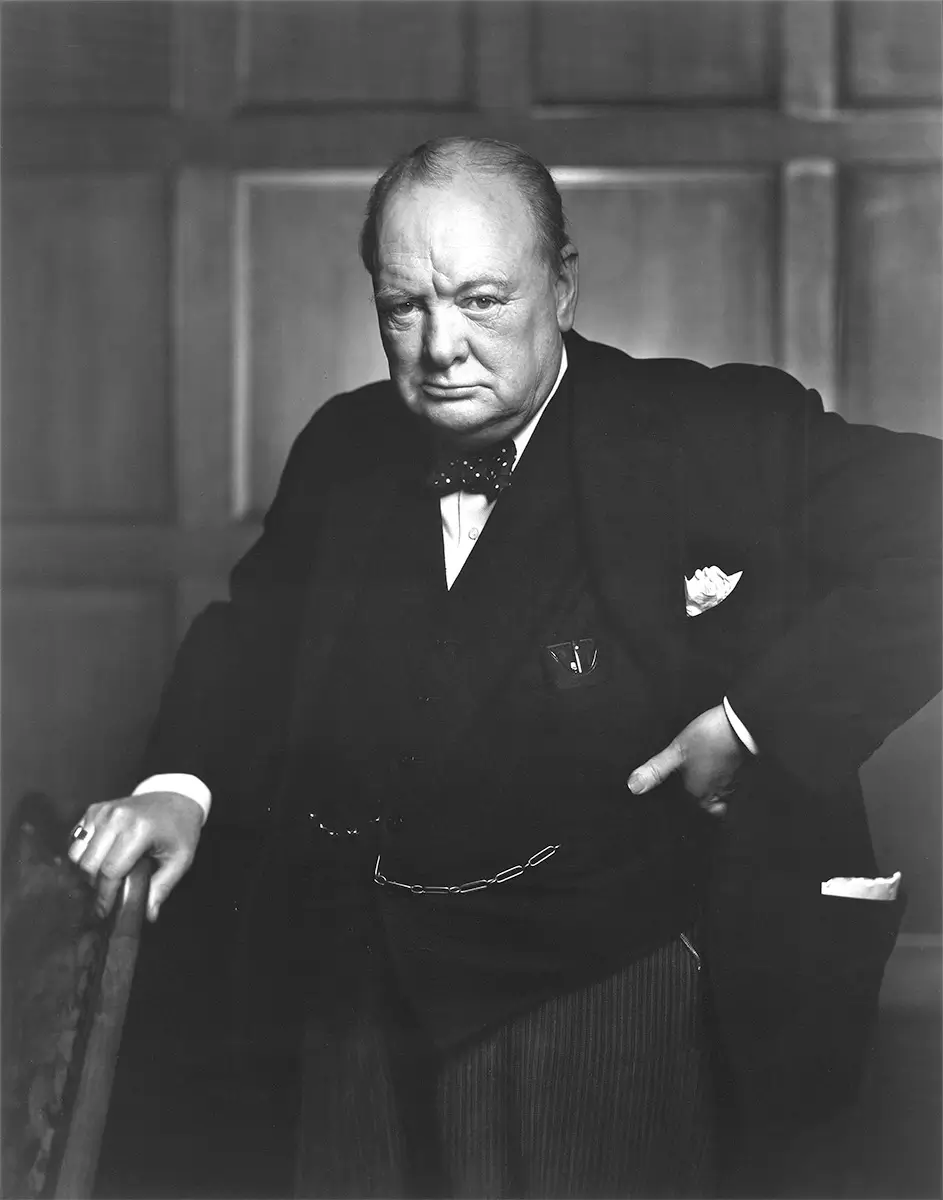
Portrait of Winston Churchill, titled The Roaring Lion, 1941 - Yousuf Karsh. Library and Archives Canada, e010751643 © Yousuf Karsh
Sometimes, whether or not the photographer is pleased with the outcome, sitters will carp, even
if good-naturedly, about how they look. “That’s not me,” they’ll say, or, “I never look good in
pictures.” They may agree it’s a fine photograph, just a bad likeness. There is a technical
explanation for that phenomenon.
Your each and every day begins, and often ends, with staring into a bathroom mirror.
What you see — what you’ve gotten used to seeing — is an optical illusion created by light
bouncing off your face and onto the glass surface of the mirror, then back again. The light travels
measurably twice the distance from your eyes to the mirror, revealing an effect called optical
foreshortening. It changes the apparent distance (your perception) between objects in the
foreground and background relative to where you are standing. Looking at yourself in a mirror is
like seeing yourself through a telephoto lens.
Some people call a telephoto lens a “portrait lens” because it flatters by, well, flattening.
It compresses visual perspective, which means it makes the tip of your nose look closer to your
ears. The effect is subtle, but it’s plain to see in two dimensions (pun intended). Alternatively, if
you are photographed up close with a wide-angle lens, you’ll have a big schnoz and smaller ears,
the way you’d look to someone who got “in your face,” standing nose to nose. It’s not that you
look bad in photos. It’s just that you expect to see something different, more familiar: your
reflection in a mirror.
Incidentally, once, while trying to explain this phenomenon to a sitter, I suffered an
embarrassing but funny moment. It was during a photo shoot with John Dean for Time magazine
to mark the tenth anniversary of the 1972 Watergate break-in. Dean was President Richard
Nixon’s White House lawyer.
Dean was one of those people who expressed displeasure about the way he looked in
photographs. I tried to explain how seeing a photograph of yourself is like hearing a recording of
your voice for the first time; it’s hard to recognize it as your own. When that came out of my
mouth, Dean looked at me as though I had deliberately insulted him. (Good expression, though!)
It was Dean, after all, on the secretly recorded White House tapes, who warned Nixon, “There’s
a cancer on the Presidency.” Seconds later, we both realized my faux pas and had a good laugh.
There’s more. You see your reflection in the mirror backward; it’s flipped, reversed. That,
too, plays tricks on your visual perception, this time with facial symmetry. The camera sees you
the way everybody else does: un-flipped.
The typical quality of bathroom lighting complements the mirror’s cosmetic makeover. It
bounces off walls, ceilings, and countertops or comes through a skylight. Shadows are softened
or altogether absent. The bounced and nearly shadowless quality of light diminishes facial lines
and wrinkles. Sometimes bathroom mirrors are surrounded by soft-white lightbulbs installed to
diffuse the light reaching your eyes. (Imagine a dressing-room vanity designed for makeup
application.) This effect, too, flatters by removing shadows.
Sorry, but the way you look in photos is how you really look! But don’t worry. You’ll
discover the magic in how you become more attractive as your photographs age.
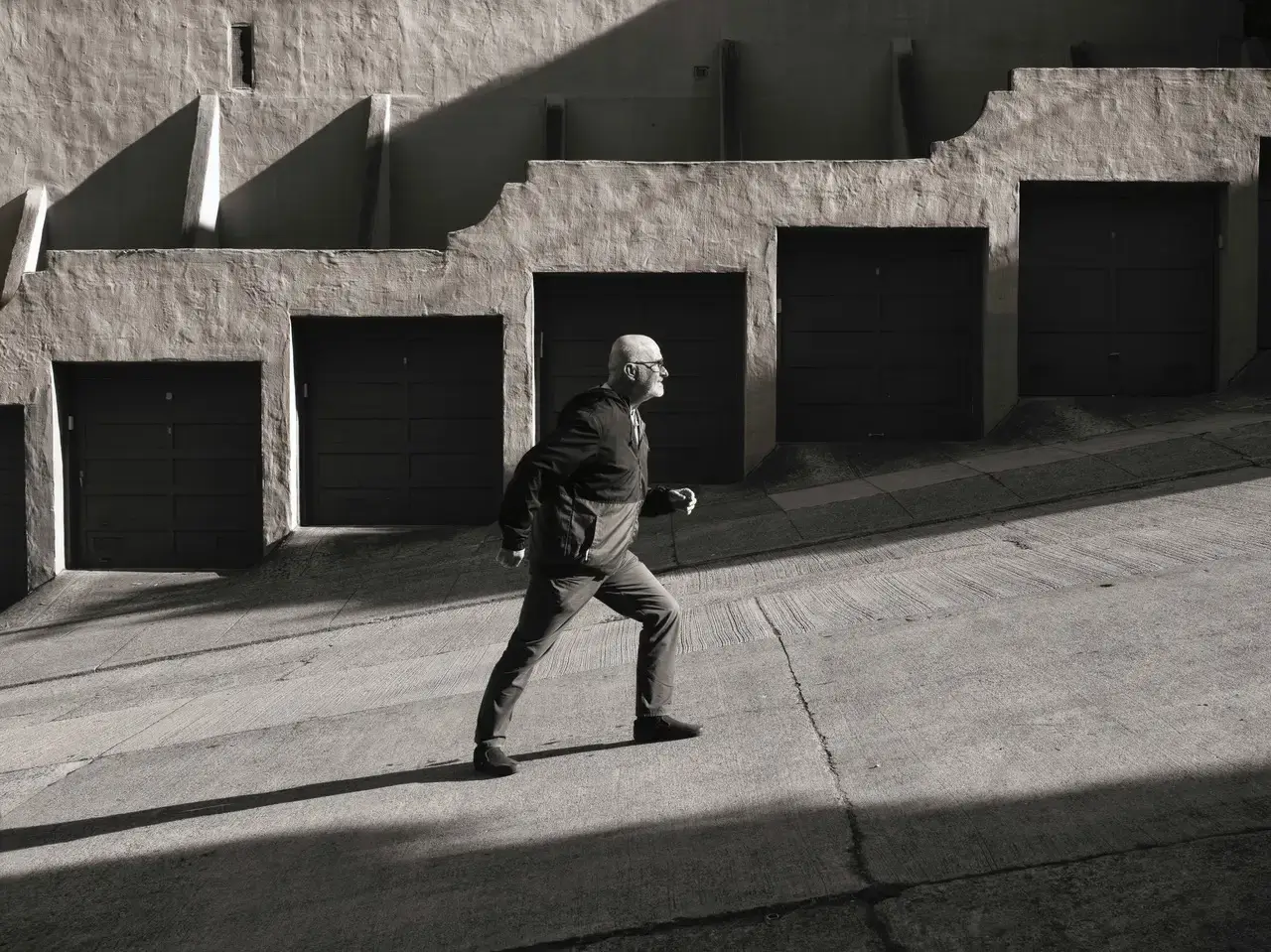
Zeki, Filbert St © Tom Zimberoff
It isn’t unusual to ask sitters to hold uncomfortable poses. (Surely, stretching one’s arm for a
selfie with a self-aggrandizing smile plastered on one’s face can’t be comfortable, either.)
Conscientious portrait photographers seldom ask subjects to strike a pose we haven’t seen them affect on their own. We simply recreate it. That’s why I, for one, do a lot of looking before
shooting. Posing suggestions may seem nutty to the sitter, so I leave them open to discussion.
My posing philosophy goes something like this. If I were to cut one frame from a strip of
movie film, it might show someone taking a step in one direction, an unresolved freeze-frame
captured while moving between point X and point Y with, let’s say, one foot off the ground
accompanied by a head turn. Sure, it will feel awkward to hold still like that, but it can be what
makes or breaks a composition.
No rule says photographers have to make their subjects feel comfortable. We are
sometimes engaged in a subtle game of control versus resistance, sometimes approaching
obstinance, unsure of each other’s motives. Because photographers are ultimately in control,
sitters may feel vulnerable. Therefore, photographers have a responsibility to cultivate trust
without squandering that currency. We won’t allow the distribution or publication of
embarrassing poses — outtakes. But the longer a photographer can cajole the sitter to linger in
front of a lens, the less determined they are to maintain a self-conscious façade.
It’s fanciful to imagine a lens as a sculptor’s chisel, chipping away at the surface to reveal
what lies underneath. I tell sitters that it only takes 1/125th of a second to shoot a picture and that
when we’re no longer having fun, we’re done. But I also try to persuade them that the longer
they stay in front of the camera, the better our results will be. If we’re lucky, the result can
transcend the encounter itself.
On another note, self-portraits notwithstanding, a portrait should not be expected to
flatter. Of course, there is no reason why it cannot. Many great ones do. It’s just not the general
intent, not a prerequisite. However, it’s reasonable to say that a portrait should never be
deliberately insulting. The parties on opposite ends of a lens, let alone critics, don’t always agree on what is good or bad. For instance, some photographers may have no compunctions about
showing every whisker and pore on a man’s face. But would we dare show such sharp detail on a
woman’s face? It depends. There will certainly be exceptions. What about retouching in post-
production? What about makeup? Even men need a little help sometimes. It may be a practical
consideration for, say, a magazine cover if not for art’s sake. There are no rules governing
personal photographic style and technique.
Portraitists, whether they rely on film, pixels, pencils, or paint, are storytellers. Those
who use a camera are concise storytellers indeed because they work in a medium with only two
dimensions (unlike sculptors) and only one frame (unlike moviemakers). Portrait photographers
have less leeway for explication than writers (in particular biographers), who can exploit their
readers’ boundless imaginings. One also hopes to make a portrait during an important episode in
the subject’s personal life or career because it adds to a good story, and the moment itself is
preserved in a historical context.
A compulsion to create art defines humanity. Seeing humans as the subjects of art comes
full circle with portraiture. When photons bounce off living beings and pass through an aperture of glass, propelled further through the barrel of this lens by an occult force called “the
mind’s eye” to converge at a focal point on a light-sensitive substrate inside a dark box, two
parties on either side of this contraption, a camera, are committed to telling a short story for one
endlessly enduring moment. That’s portraiture, the still life of a human being. It’s magic.
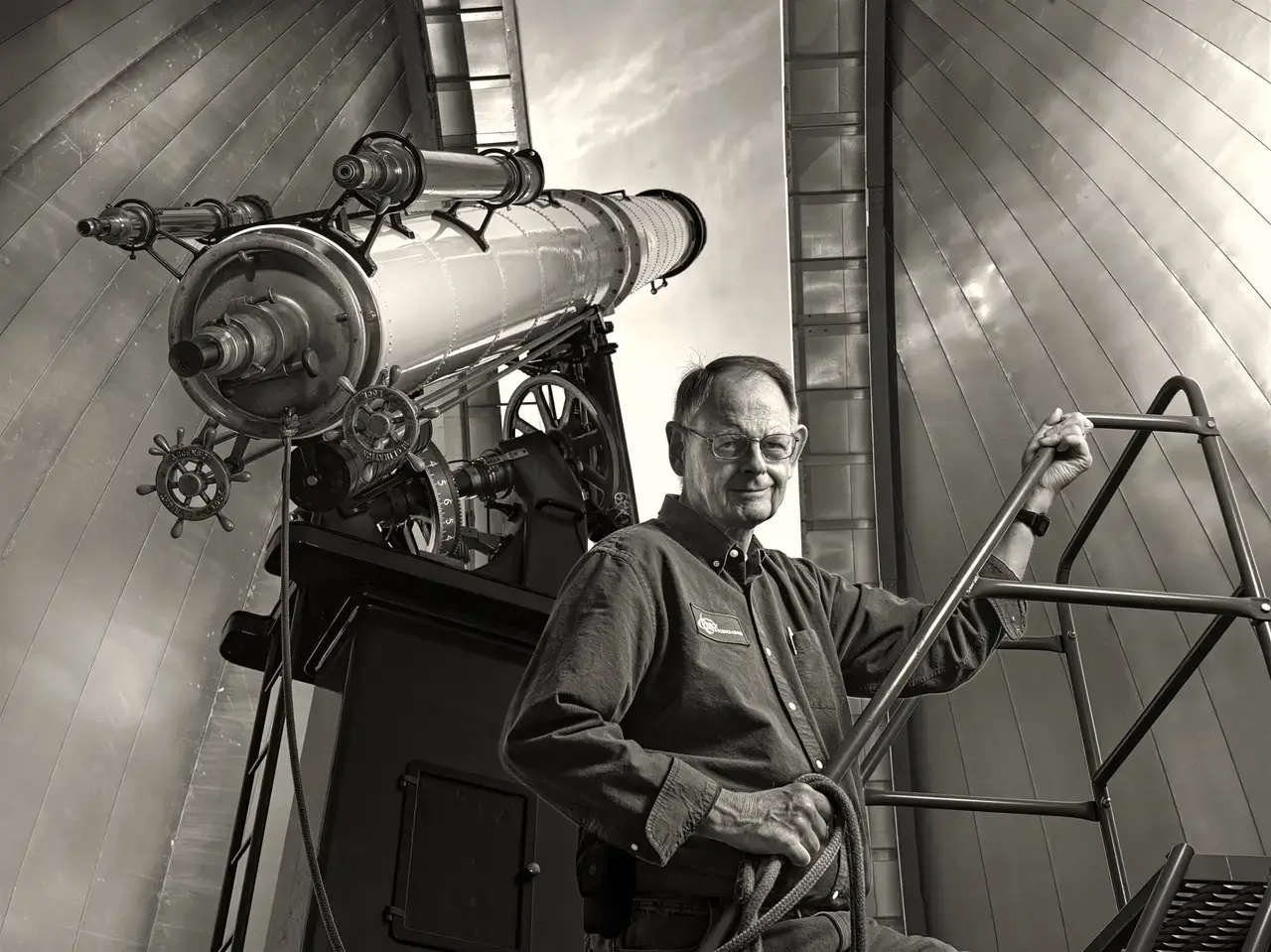
Gerald McKeegan, Chabot Telescope © Tom Zimberoff
